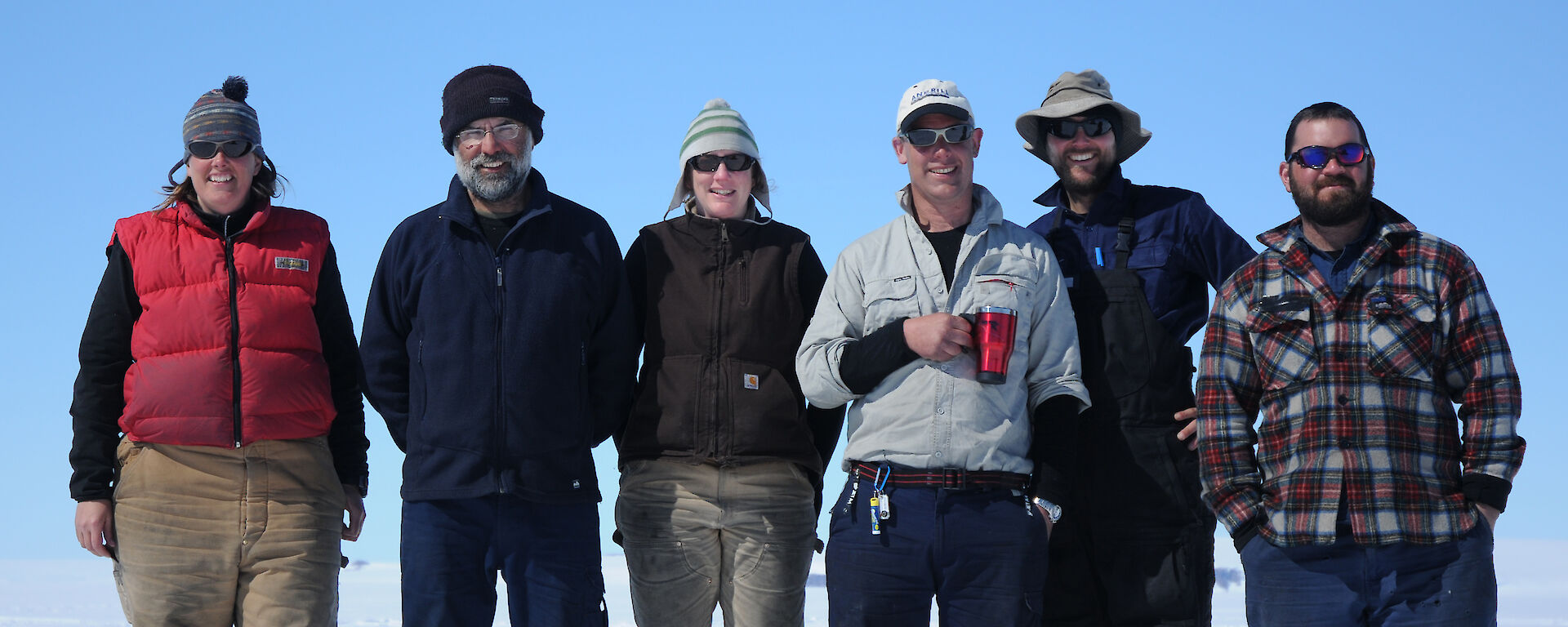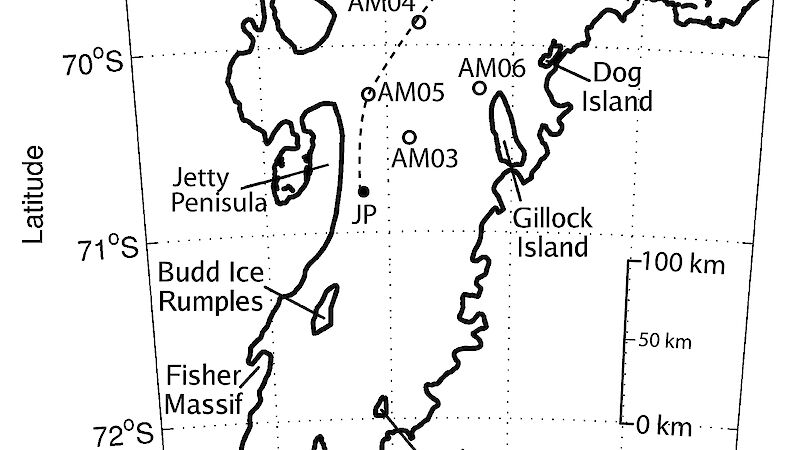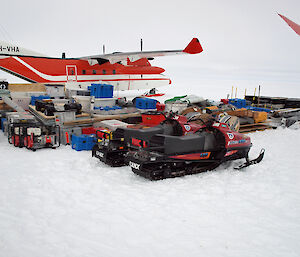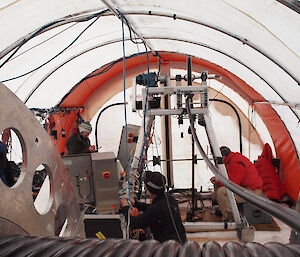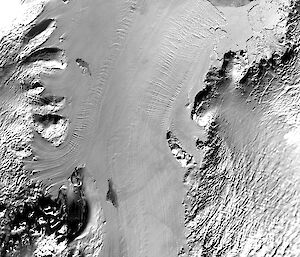The Amery Ice Shelf Ocean Research (AMISOR) project has been running since the 1999–2000 Antarctic summer. A central pillar of the program has been the use of a hot water drill system to create boreholes through the ice shelf to access the underlying ocean. Whilst the 2009–10 season was the last for borehole drilling, instruments moored at each borehole site will provide information on ice shelf-ocean interactions for many years to come.
The Amery Ice Shelf, located between Davis and Mawson stations, is the largest ice shelf in East Antarctica and third largest in Antarctica. It has an estimated floating ice area of 60 000km2 and a catchment region that drains approximately 16% of the East Antarctic grounded ice sheet area. The Amery Ice Shelf has been a key site of Australian glaciological research since the 1960s. As a part of this research effort the AMISOR project aims to quantify ice shelf–ocean interactions and their impact upon the discharge of grounded ice, modification of water masses and the conditions leading to the formation of marine ice (a layer of ice up to several hundred metres thick, formed on the base of the ice shelf by the refreezing of sea water). Scientists suspect that bands of marine ice that form on the base of the shelf may influence its stability and dynamics.
A major component of the AMISOR program has been hot water drilling at various locations on the Amery Ice Shelf to access the underlying ocean for sampling (Australian Antarctic Magazine 12: 32–33, 2007). Since commencing with a trial season in 1999, seven boreholes have been drilled. The hot water drill has interchangeable drilling and ice coring attachments which has enabled 14 ice cores to be recovered from targeted depths within the ice shelf. Once the borehole extends through the entire shelf thickness a range of instruments are used to take snapshot measurements of the ocean properties beneath the ice. For longer term monitoring of the ice and ocean a mooring of instruments extending from the surface to just above the sea floor is left in place at each borehole. During the summer field season, instrument moorings at previous drill sites are visited to download oceanographic and glaciological data. Despite the end of drilling on the Amery Ice Shelf for the time being, these annual visits provide data that are vital to ensuring our insight into the seasonally variable conditions of the ice shelf continues into the coming years.
The 2009–10 field season had a great start with the twin turboprop aircraft (C-212) ready and waiting at the Davis sea ice ski-way for the 15 tonnes of field gear and six-person drill team that arrived from Hobart in November. One week and 18 return flights later the entire drill system and team were in place at the fifth AMISOR borehole site, creatively named AM05. This site was located 20km from Jetty Peninsula and the Beaver Lake region near a band of marine ice frozen onto the base of the Amery Ice Shelf. Two previous boreholes have been located along an ice flowline on this band of marine ice. The addition of a further instrument mooring in this region will assist our understanding of ice shelf–ocean interactions and their influence on marine ice layer formation.
The 2009–10 drill season saw a mix of old and new AMISOR personnel. Shavawn Donoghue, Al Elcheikh and Adam Treverrow were joined by Kelly Brunt, Steve Cann, Adam Christensen, Jeff Cumpston and Jeremy Ridgen, who all made their AMISOR debut. The team was able to finish drilling and mooring operations at AM05 with plenty of time to spare for a second borehole. AM06 was drilled a short 63 km to the east of AM05 and right next door to Gillock Island and its occasional mists. In contrast to AM05, where marine ice forms on the base of the shelf, AM06 is located in a region where modelling indicates in-flowing water from the open ocean produces strong melting at the ice shelf base.
The move to the second drill site occurred on 23 December with a great effort from all pilots and engineers of Helicopter Resources and several welcome pairs of helping hands from Davis. The following days were spent rebuilding the drill system and camp in time for a Christmas roast. Drilling restarted on 29 December, making it the quickest ever set-up of the AMISOR drill system. The good run continued with the AM06 borehole and mooring also completed in record time, enabling three of the team to return to Hobart in January. The remainder of the team stayed at Davis until February to coordinate retrieval of all drill and camp equipment from the ice shelf and packing for return to Hobart.
The AMISOR community thanks all those involved for making each drilling season run smoothly these past 11 years.
ADAM TREVERROW and SHAVAWN DONOGHUE
Antarctic Climate and Ecosystems Cooperative Research Centre
Ice shelves and global climate
Antarctic ice shelves, such as the Ross, Filchner–Ronne and Amery, are important components of the global climate system as they form an interface between the grounded Antarctic ice sheet and the surrounding ocean. Whilst the melting of floating ice shelves has only a minor influence on sea level, they provide a buttressing effect that retards coastal discharge of ice from the interior of the continent. Following the break-up of the Larsen B ice shelf on the Antarctic Peninsula during 2002, satellite measurements indicated accelerated ice discharge from glaciers flowing into the collapsed region of the ice shelf and an increased rate of sea level rise.
Large ice shelves are strongly affected by complex interactions with the oceans and contribute to the formation of water masses important to global ocean circulation. These interactions link ice shelves and the global climate system via ocean circulation. This linkage means changes in global climate can influence the mass balance (total gain or loss of ice) of the Antarctic ice sheet and vice versa. Modelling has indicated that global warming can strongly influence ice shelf mass loss and dense water (cold and salty) formation through melting at the base of ice shelves. In addition to basal melting, complex ice shelf–ocean interactions beneath the Amery Ice Shelf produce significant refreezing at the base of the ice shelf resulting in the formation of a layer of marine ice, up to several hundred metres thick in places. The spectacular jade coloured icebergs encountered in Prydz Bay and along the Fram Bank are marine ice from the base of the Amery Ice Shelf.

